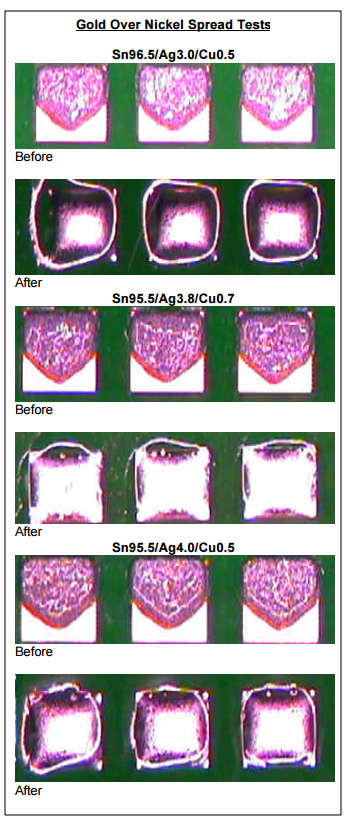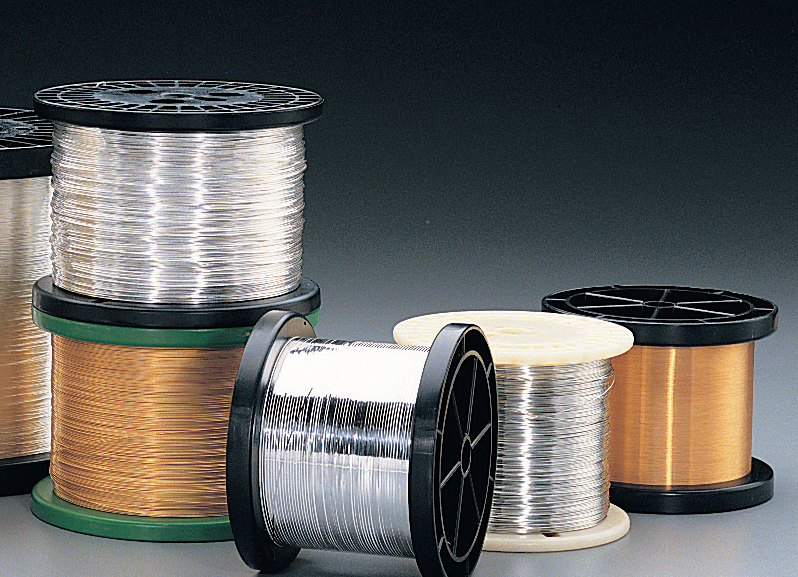The thicker OSP finish 06µm resulted in higher wetting performance with both the SAC 305 and Innolot-based pastes versus the 04µm thick OSP pad finish. There is usually no need for flux when soldering silver plated copper conductors.

A Comparison Of Tin Silver Copper Lead Free Alloys Aim Solder
Similar to the case of glasses ceramics or refractory metals the underlying base metal is isolated.

Effect of surface finish on tin silver copper solder alloy. Silver content decreases solubility of silver making the alloy suitable for soldering silver-metallized surfaces eg. Provides solid solution hardening AND lowers the liquidus point of the tin based system. Experimental Sn-Ag-Cu Solder Alloys.
Tin-silver-copper based alloys give joints with a rougher non reflective surface. This may result in unsoldered areas and may result in solder displacement to areas close to the joint with the potential to create shorts. The decision to use a surface finish is based on the premise that the desired level of solderability could not be realized with the conditions of the substrate surface at the time of soldering.
Tinsilvercopper SAC solder alloys have been introduced as primary alternatives to the eutectic tin-lead solder. Provides solid solution hardening BUT increases the liquidus point of the tin. Tin-silver-copper is a lead-free alloy commonly used for electronic solder.
Nickelimmersion silver ENImAg was developed as an alternative surface finish. The micro-alloyed solder pastes proved to be more reliable than SAC305 alloy. Effects of Transition Metals on Vickers Hardness and Ultimate Tensile Strength of Sn-4.
Each combination of solder alloys and surface finishes created a measured IMC between 09µm and 27µm. Solder alloy that is used. In this study ball grid array components with tinsilvercopper SAC solder spheres were processed using a tinlead reflow profile and then subjected to thermal cycle testing from -55ºC to.
Can lower the liquidus of the alloy however cost considerations ruled it out at an early stage. Adding elements such as Bi Sb Ni and Co to the SnAgCu solder joint was found to improve the fatigue resistance and slows down the adverse effect of aging and. Provides dispersion hardening by means of Intermetallic phase formation.
It is the main choice for lead-free surface-mount technology assembly in the industry as it is near eutectic with adequate thermal fatigue properties strength and wettability. The following elements were considered as additions to the tin-silver-copper matrix. It is essential to conduct research focusing on the material aspects of the SAC alloy.
ASTM B 298 defines the parameters for silver plated conductors. Tin and silver alloy in packaging suitable for wave soldering machines and tinning crucibles. SMD capacitors and other silver-metallized ceramics.
The process typically undergoes five. Lead-free solder is gaining much attention as the environmental effects of lead in industrial products is recognized and as a result of Europes. The substrate and surface finish on the PCB play a significant role in soldering where it reacts with tin Sn in the lead Pb-free solder balls to form a solder joint.
The immersion plating process is self-limiting which limits the maximum thickness of tin. This is typical of SAC alloys tinsilvercopper commonly used in lead-free soldering applications. The effect of various surface finishes on the interfacial fracture toughness of SAC405 solder joints under shock loading conditions was investigated using sandwich compact tension specimens.
Immersion silver is a finish similar to immersion tin but silver metal is plated over the copper. Tin-lead HASL uses Sn63Pb37 alloy while lead-free HASL uses tincopper based alloys like SN100C. 15 17 21 Not recommended for gold.
Printed circuit board PCB surface finish and its reactive wetting process were identified as a main cause of voiding. Alloy toward Pb-free solder alloys such as tin-silver-copper Sn-Ag-Cu melting and eutectic temperatures also change requiring modification to the solder reflow profile. Various surface finishes are thus developed such as electroless Ni based finishes finishes on copper Cu and mixed finishes.
Immersion tin is flat and solders well initially. Pure Copper Tin and Nickel and Their Intermetallics. Lead-free soldering temperatures can damage the finish causing subsequent soldering steps to be challenging.
During reflow soldering liquid flux residues adhered to the interface PCB liquid solder alloy form voids while the solder alloy is in a liquid state. 380 x 15 x 8 mm. Conducted to evaluate the solder joint integrity impact of reflowing a Pbfree solder alloy using a tinlead reflow profile.
Most joints soldered with lead-free solders exhibit a dull or frosty appearance. Therefore the effect on an interfacial reaction between lead-free solder and ENImAg surface finish using different solder ball size Ø300µm Ø500µm and Ø700µm was investigated. Physical and Mechanical Properties of Lead-Free Alloys and Sn-37Pb eutectic Table 119.
SAC alloys come in a variety of silver concentrations each with its unique attributes. Room-Temperature Physical and Thermal Properties. The tinsilvercopper SAC alloy is highly adopted and seems to be the obvious choice for a lead-free soldering alternative to eutectic tinlead SnPb solder.
The other difference is cosmetics of solder joints. SAC joints also exhibit hot tears as detailed in IPC-610D Section 5. SAC alloys are relatively new alloy systems in packaging applications and existing studies are limited and confined mainly to the materials assembly process and finite element modeling.
In general the amount of lead-free solder wicking depends on the surface finish of the pad and the finish of the component lead. All samples were subjected to an aging process with different aging times. Previous testing has demonstrated that the high-silver tin-silver-copper alloys can suffer from reliability issues as the result of large plate-like Ag 3 Sn structures that grow rapidly during the liquid phase of the reflow profile before the final solidification of the solder joints.
Surface Finish Affects Wetting. For each surface finish the alloys involved in the study were analyzed. Immersion tin is also susceptible to handling damage because it is relatively thin.
This differs from the smooth bright shiny surfaces experienced with tinlead solders. 1 Inadequate substrate solderability can arise during the course of one of two general pretexts. Lead-free HASL also has the inherent issue of non-planarity but solders quite well through multiple soldering cycles.
Unlike tin silver does not form intermetallic compounds with copper and shelf-life is excellent with standard sulfur-free protective wrapping and. In contrast to that no voids are found when no reactive wetting occurred. It was observed that the new elements have positively contributed to the component reliability.
Request PDF Effect of surface finish metallurgy on intermetallic compounds during soldering with tin-silver-copper solders Solder joint reliability is dependent on both thickness and. The soldering and solidification of the solder joints result in the formation of several microstructures such as Sn dendrites eutectic phases interfacial intermetallic compound IMC layer and primary IMCs. Xi This testing has shown that when the Sn955Ag38Cu07 and Sn955Ag40Cu05 solder alloys are exposed to slow cooling rates large Ag 3 Sn.
As a starting point for a review of the basics of the reflow process a typical thermal reflow profile is shown in Figure 1. Tin-copper based solders with certain additives such as nickel and bismuth do not show as much surface shrinkage effects. Product Form Granules Melting Point 221C Percent Silver 4 Percent Tin 96 Product Weight 500g.
How Does Surface Finish Affect Solder Paste Performance Solder Paste Solder Flux Fct Solder

Pdf Analysis Of Surface Roughness And Contact Pressure At Copper Connector Using Nickel And Silver Plating For Ev Battery

Yellow Brass 2 Custom Metal Finishes And Patinas Custom Metal Metal Artwork Metal Screen

Why You Don T Want A Copper And Silver Mokume Gane Ring James Binnion Metal Arts

Pdf Impact Of Multiple Reflow On Intermetallic Compound Of Nickel Doped Tin Silver Copper On Enimag Substrate
Tidak ada komentar